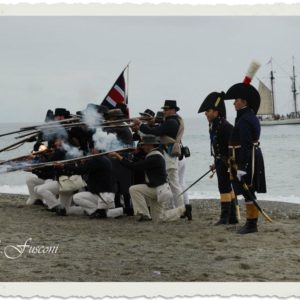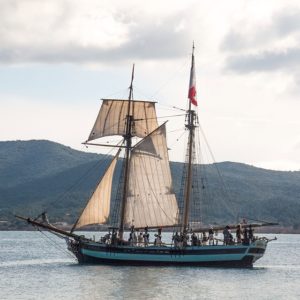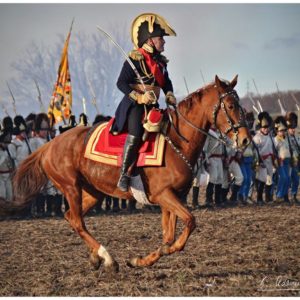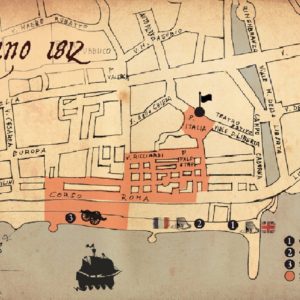{:en}It will take the city back more than two hundred years to the time of the naval battles of the Napoleonic era the historical reenactment scheduled at Loano from October 5 to 7. The initiative, promoted by the City of Loano's Department of Culture and Tourism and organized by Loano's “51eme Demi Brigade de Bataille” association, will involve Europe's best re-enactment units, which for three days will plunge the City of Doria back into the time of the clashes (off shore and on the coast) between French and British troops using clothing, weapons and equipment used at the time. These clashes lasted throughout the Napoleonic period, from 1794 and until 1815.
“Reenacting the battles and clashes that occurred in our area during the Napoleonic era has now become a fine tradition,’ explains Mayor Luigi Pignocca, ’The re-enactment held every year is not just a tourist event, but also and above all a cultural event. Every year, in fact, the association ”51eme Demi Brigade de Bataille' chaired by Andrea Puleo brings it back to our town a different moment of the Napoleonic era, thus helping to spread in a different and very compelling way the knowledge of a period that constituted a fundamental chapter in the broader history of this territory. As witnessed by the presence of our city's name on the Arc de Triomphe in Paris, in fact, the battle of Loano in 1795 was strategically very important as it completely changed the course of history: for the first time after the Revolution, in fact, France from besieged became conqueror and this set the tone for all the events that followed the arrival of the young general Napoleon Bonaparte, allowing him to find his way clear thus making his fortune. We thank Marina of Loano for hosting Pandora and Melville, the two beautiful boats that will participate in the event.".
“For three days,‘ adds Councillor for Tourism and Culture Remo Zaccaria, ’hundreds of figures from the best re-enactment units on the continent will animate our city by setting up camps, carrying out patrols, and bringing to life clashes and battles that will reenact in a historically perfect way the events that took place more than two hundred years ago. Enriching the event will be the presence of two authentic sailing ships, including the ship ’Pandora”. The historical re-enactment of Loano is an extremely engaging event that is a great success with the public every year, but, as the mayor pointed out, it is also a cultural event that draws directly from the history of our city by reconstructing facts that determined its subsequent destiny, and it is therefore important to remember it. Therefore, again this year, with great pleasure we have worked alongside Andrea Puleo and the 'association to reintroduce this event to our fellow citizens and guests.".
The reenactment jumps back to 1812, the year when northwestern Italy (Liguria, Piedmont, part of Lombardy, Tuscany, and part of Latium) was annexed to Napoleon I's French Empire. The rest of the north was part of the Kingdom of Italy ruled by Napoleon I, who on May 26, 1805, crowned himself king in Milan Cathedral by placing on his head the ancient Iron Crown of the Lombard rulers, which had always been kept in Monza Cathedral.
The French army is engaged in the ruinous Russian campaign: in June 1812 Napoleon enters it by crossing the Njemen at the head of 500,000 men; on December 10 he will return with just over 37,000 soldiers. Meanwhile, the Mediterranean is ploughed by the British fleet, which seeks to disrupt and make difficult the French trade and supplies that take place by sea. Countless actions of raids and sabotage were carried out along the entire coast of our peninsula, from Ventimiglia to Trieste, continuously from 1796 to 1814.
In 1796, then-Commander Nelson captured four French vessels that had taken refuge in the roadstead of Loano: this episode is important for understanding the strategic and political situation in Liguria, given the characters who took the field. It is in 2016 that the remains of the famous March 1795 naval battle ’Battle of Capo Noli,“ also known as the ”Battle of Genoa,“ were discovered 70 meters deep and about half a mile offshore between Noli and Finale Ligure. This clash brought out the strategic prowess of the then captain and future admiral Horatio Nelson, who in command of the 64-gun vessel ”Hms Agamemnon“ precisely at Cape Noli achieved his first important personal victory, earning promotion to squadron command.
This episode is considered in fact the first real and decisive naval battle in the Mediterranean between the Anglo-Napolitan fleet and that of Revolutionary France, i.e., the most powerful of the time, and saw among its protagonists some of the most important figures in naval history of all time, such as the future Admiral Francesco Caracciolo, in command of the 74-gun liner “Tancredi” and in charge of the Neapolitan contingent. The materials unearthed two years ago are French-made bronze cannons dated between the 18th and 19th centuries, rare military rifles in use by shipboard crews of the French Revolutionary Navy, and similar items in use by navies of the time. It is likely that these constituted part of the war equipment of two French ships, the Ca Ira and the Censeur, the former semi-destroyed and later captured and the latter set on fire by the British.
Other landing attempts occurred in May 1810 at Noli and Vado Ligure, but French garrisons managed to repel the landings. In 1812 the British fleet pursued eighteen boats that found refuge in Ligurian ports in the West: at this juncture, 200 Royal Marines landed on our shores, capturing two coastal batteries. After the clashes, the British retreated and plundered sixteen of the eighteen boats despite violent French fire.
In the same year another convoy of Latin-sailed vessels, also pursued, found refuge in the port of Laigueglia. The ships first suffered a naval bombardment that weakened the French garrison and later a landing that culminated in fierce bayonet battles. The British killed two officers, twenty soldiers and took fourteen prisoners. The battalion commander Beniamino Garnier, who was later awarded the Legion of Honor along with Private Giuseppe Burle, also died in the clashes. The next day, following more fighting, the British were also repulsed with the help of the Leiguegliese, who joined the French garrison. Retreating, the British put two of the coastal battery's guns out of action by pushing them back and destroying several carriages and materials. All sabotage and raiding actions ceased after the fall of Napoleon in 1814.
This year's re-enactment reconstructs in broad strokes the events that took place in those years in the territory of Loano and the western Savona area and that saw characters of important caliber write part of our history.
The event will kick off on Friday, Oct. 5: at 2 p.m. the setting up of soldiers“ camps at the Miramare Baths, the Delfino Baths and the Kursaal Baths will begin; at 4 p.m. the troops will be on a free-for-all and will ”patrol“ the historic center; starting at 8 p.m. the ”patrols" through the city will begin.
On Saturday, Oct. 6, a general assembly will be held at 9:30 a.m. in Piazza Italia; at 10:30 a.m., ddraining maneuvers will begin in the streets of the historic center by department heads. At 3:30 p.m. the landing of the British troops will take place at Bagni Virginia, Bagni Nettuno and Bagni Lampara: this will start the first “clashes” in the streets of the center. At 5 p.m. the French troops will retreat to their camp and the British troops will assemble in Piazza Italia, where the raising of the Union Jack flag will also take place. The day will end at 8:30 p.m. with the free exit and “patrols” of the troops through the city.
Sunday, Oct. 7, will begin at 9 a.m. with the assembly and flag-raising ceremony in Italy Square. At 10:30 a.m. there will be a French counterattack while at 11 a.m. the ship Pandora will go to anchor in front of Loano beach. At 11:30 a.m. British troops will leave the coast for good, bringing an end to hostilities. The event will officially end at 1 p.m.
Among the stars of the event will be, as mentioned, two beautiful ships: the Pandora and the Melville.
The Pandora is a wooden replica of a 19th-century postal sailing ship. She is a cage schooner about 30 meters long and, because of her features, has been used as a set for numerous films. It was built in Russia in 1994 and after some travails is now used for school cruises for students of the Sail Training Association Italy. In three years (in 2007, 2010 and 2013) she won respectively the Mediterranean Tall Ships Race, the Garibaldi Tall Ships Regatta and the Lycamobile Mediterranean Tall Ships Regatta, international regattas organized by Sail Training International. Today he continues to sail for the Traditional Sailing Association, an amateur sports association whose purposes include sailing aboard boats with ’traditional’ rigging. Aboard the Pandora the “Seamanship School” is conducted, which aims to form the character of sailors and provide them with all the knowledge they need to steer the boat in total autonomy.
The Melville is a “tahiti ketch” with auric rigging. It is a cruising boat designed in the late 1920s by John G. Hanna that had a large following and was reproduced in many examples in different countries. The Melville, in particular, was built in 1952 in Venice. She is 9.50 meters long with an ’overall length’ of 11 meters.{:}




